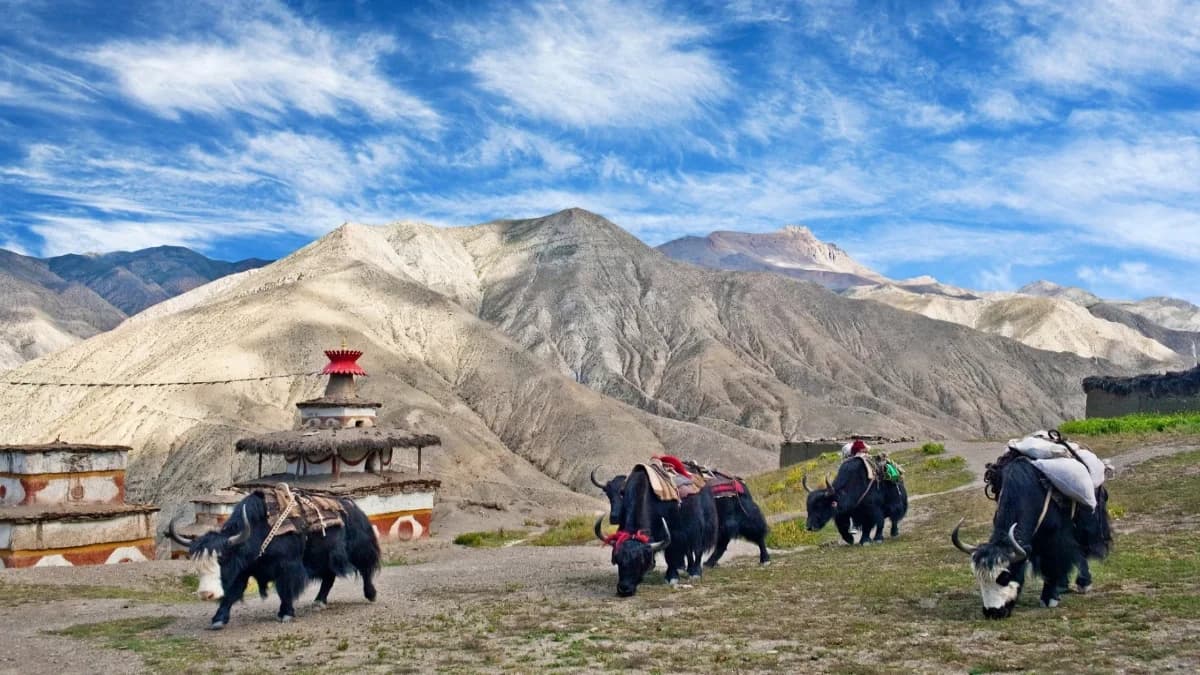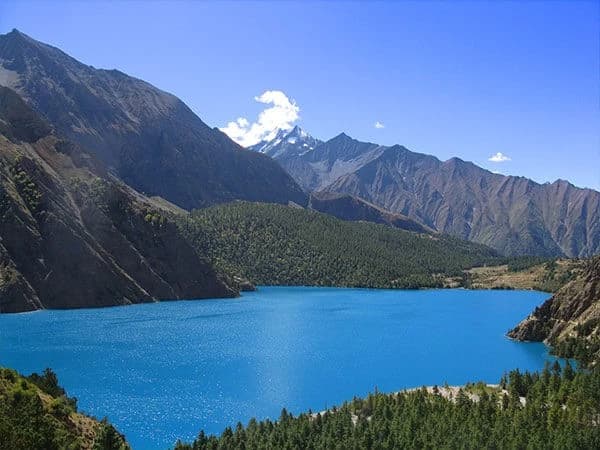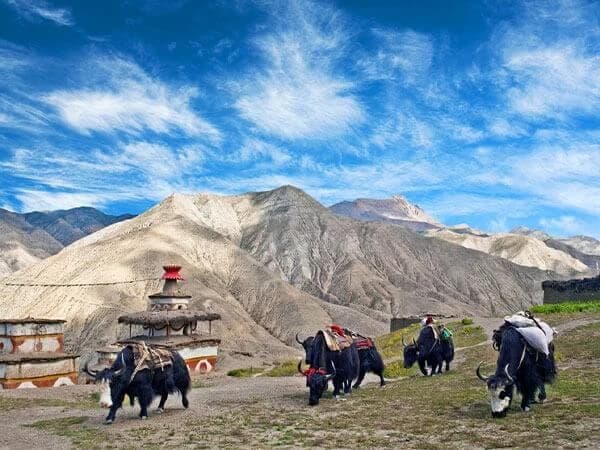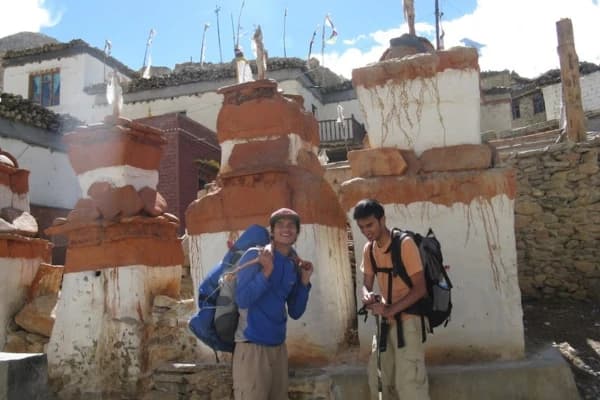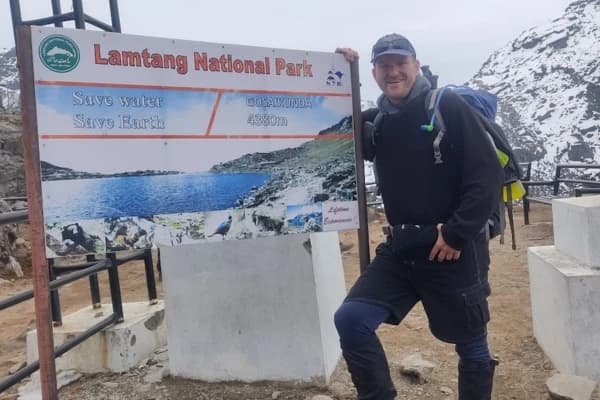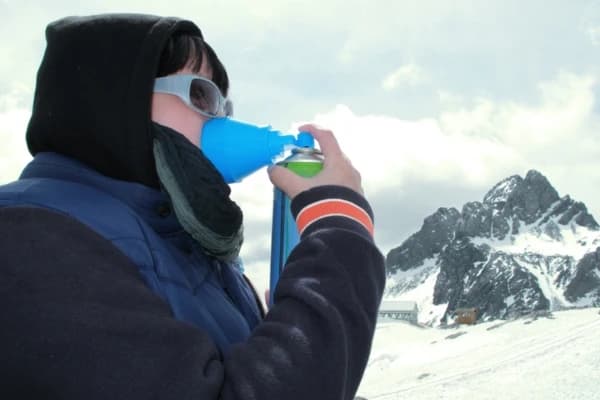Dolpo, home to the Hidden Kingdom Nepal, is in the far northwest. It is a calm region surrounded by tall mountains and full of ancient traditions. Often called Nepal’s hidden kingdom, Dolpo feels mostly untouched by time. Nature, culture, and adventure come together here. It offers a truly unforgettable trekking experience.
This Upper and Lower Dolpo Trek Guide will help you understand the routes, culture, and everything you need to know before visiting this mysterious part of Nepal. Whether you dream of seeing turquoise lakes, meeting local people, or walking on remote trails, this guide has you covered.
If you’re thinking about exploring Dolpo soon, keep reading or reach out to Nepal Gateway Trekking to plan your journey using this Upper and Lower Dolpo Trek Guide.
Where Exactly Is Dolpo Located?
Dolpo sits in northwestern Nepal, right along the border with Tibet. It lies inside Dolpa District, the largest district in Nepal, and stretches across dramatic valleys, high mountain passes, and dry plateaus.
The area ranges from about 2,500 to 5,100 meters in altitude, a bit on the low side compared to Everest and Annapurna regions. But this region includes glacial rivers, rocky cliffs, and high desert landscapes. It’s also home to Shey Phoksundo National Park, Nepal’s largest national park, and the famous Shey Gompa monastery. The region is also known for its thinly populated villages and traditional stone houses that have been unchanged for centuries.
For trekkers, understanding Dolpo region travel tips before visiting can make your journey safer and more enjoyable. A visit to Shey Phoksundo Lake trek is one of the highlights of the region, and it’s recommended in any Upper and Lower Dolpo Trek Guide.
Why Dolpo Is Called the “Hidden Kingdom”?
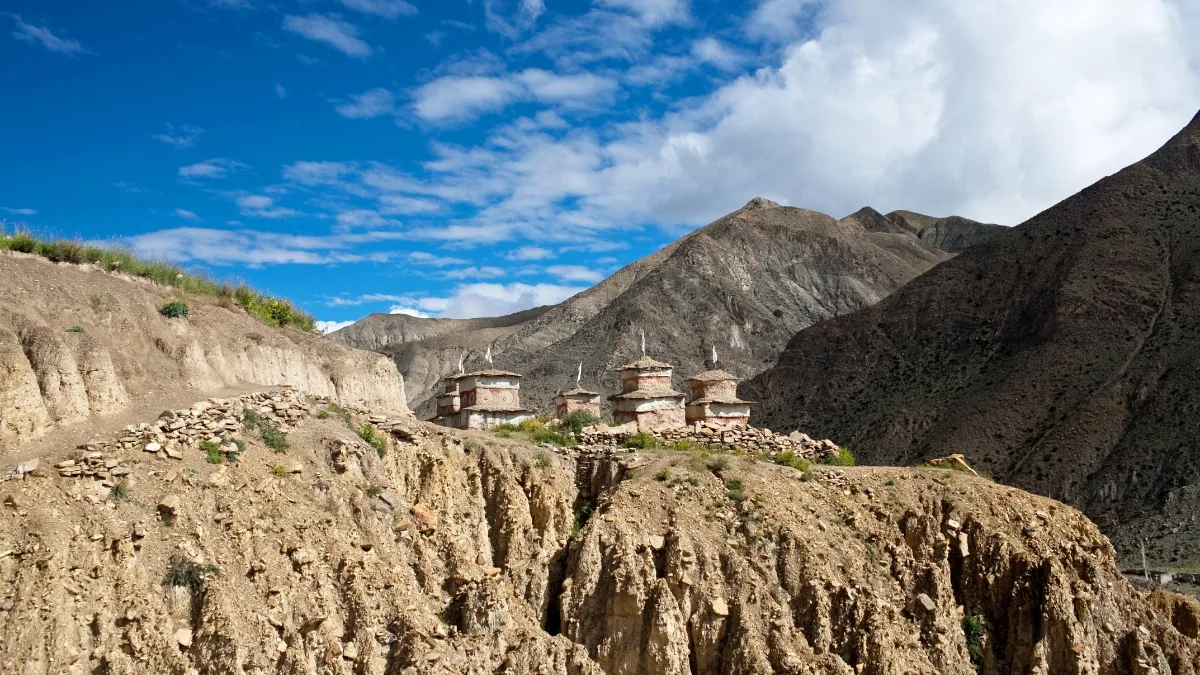
Dolpo earned the name Hidden Kingdom Nepal because it remained cut off from the outside world for centuries. Its rugged terrain and high passes kept it naturally isolated, which helped preserve its unique culture. Few people outside Nepal even knew about it until the late 20th century.
This isolation helped Dolpo maintain ancient Tibetan Buddhist traditions and the older Bon religion, both of which influence local rituals, festivals, and daily life. Legends also speak of Dolpo as part of Shambhala, a mythical land of peace and wisdom.
Today, tourism is controlled to protect the delicate nature, holy monasteries, and traditional ways of life. Travelers going to this far-off region should be ready for simple facilities and long parts with no modern comforts. Following Dolpo region travel tips from a trusted Upper and Lower Dolpo Trek Guide makes the trip safe and more enjoyable.
Start Your Upper and Lower Dolpo Adventure Today – Connect with Nepal Gateway Trekking to plan your dream trek.
Difference Between Upper and Lower Dolpo
Dolpo is divided into two main trekking areas: Upper Dolpo and Lower Dolpo. Both have amazing landscapes and rich cultural experiences, but they are very different when it comes to access, difficulty, and permits.
Upper Dolpo is extremely isolated and spiritually significant, while Lower Dolpo offers more interaction with villages and slightly easier terrain. Both treks demand stamina, proper acclimatization, and patience for remote trekking.
|
Feature |
Upper Dolpo |
Lower Dolpo |
|
Accessibility |
Remote and restricted area, limited flights, long trek days |
Easier to reach with slightly more developed trails |
|
Permit Requirement |
Restricted Area Permit (expensive, group only) |
Standard trekking permit issued locally |
|
Culture |
Strong Tibetan-Bon influence, isolated communities |
Mix of Bon and Buddhist villages, more interaction with locals |
|
Elevation |
Up to 5,100 m, high passes like Numa La & Baga La |
Around 4,000 m, moderate passes |
|
Trek Difficulty |
Challenging, long days, limited teahouses |
Moderate, shorter trek, more amenities |
|
Tourist Flow |
Very few trekkers, extreme solitude |
Slightly more visitors, still quiet and remote |
Highlights of Upper and Lower Dolpo Trek
Shey Phoksundo Lake: A bright turquoise lake surrounded by cliffs, one of Nepal’s most beautiful spots. Its depth and sacredness make it a spiritual site for local communities.
- Shey Gompa: A Buddhist monastery situated on a hill, housing monks who still follow ancient practices and manuscripts.
- Dho Tarap Valley: A wide, high valley filled with yak caravans, barley fields, and villages where life is unchanged for centuries.
- Wildlife encounters: You can possibly spot snow leopards, Himalayan blue sheep, musk deer, and numerous bird species.
- Cultural heritage: Witness Bon rituals, Tibetan Buddhist prayers, and ancient festivals celebrated in the villages.
Best Time to Visit the Dolpo Region
The best time to visit Dolpo are spring (April to June) and autumn (Sep to Oct). During these months, the weather is generally stable, trails are accessible, and mountain views are at their clearest. Spring brings blooming alpine flowers and lush valleys, while autumn offers crisp air and spectacular skies for photography.
The monsoon season (July to August) is not recommended as trails can become slippery, rivers swell, and leeches are common in lower areas. Winter (November to March) brings heavy snowfall, especially in Upper Dolpo, making passes difficult or even dangerous, and many teahouses may be closed.
Following a Upper and Lower Dolpo Trek Guide and checking the best time to visit Dolpo ensures a safer and more enjoyable experience.
Step Into Dolpo’s Untouched Wilderness – Customize your trek according to your preferred season with local experts from Nepal Gateway Trekking. Inquire now!
Trek Routes – Upper vs Lower Dolpo
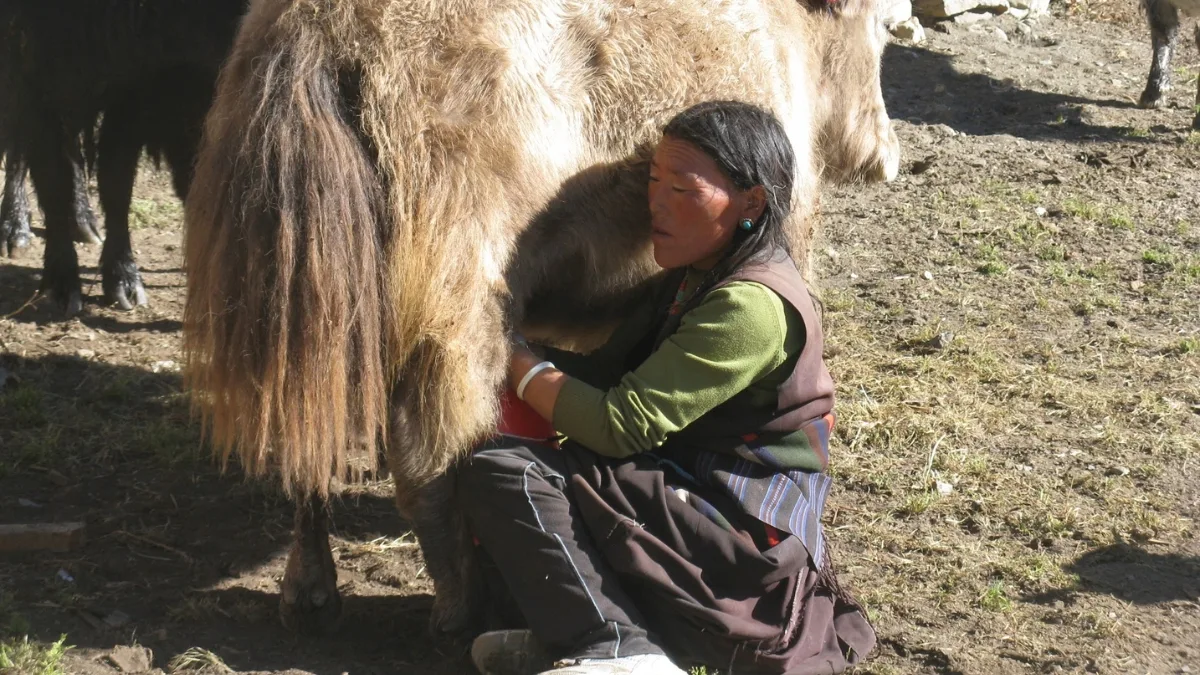
Dolpo offers some of the most remote and unforgettable trekking experiences in Nepal, but the routes differ a lot depending on whether you head to Upper Dolpo or Lower Dolpo.
Upper Dolpo Trek Route
The Upper Dolpo trek usually starts with a flight to Juphal, followed by trekking through Dunai, Phoksundo Lake, Shey Gompa, and Tarap Valley. The trail crosses two high passes named Numa La and Baga La, which can reach above 5,000 meters.
This trek takes 22-27 days and is extremely remote. Trekkers must carry camping gear and may face long stretches without villages or lodges. Because Upper Dolpo is a restricted area, a special permit and a registered guide are mandatory. A proper Upper Dolpo trekking guide is invaluable for navigation, permits, and cultural insights.
Lower Dolpo Trek Route
The Lower Dolpo trek is shorter and moderately easier. Starting from Dunai, it passes through Ringmo village, Phoksundo Lake, and nearby valleys.
Lower Dolpo allows closer cultural interaction, with more villages to visit and traditional houses to see. Trekking here takes 14–18 days, with moderate altitude changes. Accommodation is slightly better, and permits are simpler, though trekking still requires careful planning and acclimatization.
Route Comparison Table
|
Route |
Duration |
Difficulty |
Highlights |
Permit |
Accessibility |
|
Upper Dolpo |
22-27 days |
Hard |
Shey Gompa, Numa La, Baga La |
Restricted Area Permit |
Remote, flight to Juphal |
|
Lower Dolpo |
14-18 days |
Moderate |
Phoksundo Lake, Ringmo village |
Standard permit |
Easier access via Dunai |
Alternative Routes & Side Trips
The Tarap Valley, Limi Valley, remote monasteries, and trails toward Crystal Mountain provide lesser-known trekking options. Incorporating these routes into your Upper and Lower Dolpo Trek Guide adds adventure while respecting Dolpo region travel tips.
- The Tarap Valley is a stunning high-altitude valley with traditional stone villages, barley fields, and yak herding communities, offering a quieter experience than the main Upper Dolpo route.
- The Limi Valley, located near the Tibetan border, features ancient Bon and Buddhist monasteries, traditional festivals, and spectacular mountain scenery, requiring extra days and careful acclimatization.
- Beyond Shey Gompa, trekkers can visit remote monasteries scattered across Upper Dolpo, which are culturally rich and often inhabited by monks living a simple, spiritual life.
- Some side trails lead toward Crystal Mountain and nearby glaciers, providing high-altitude adventure with unparalleled views of snow-capped peaks and rugged landscapes.
Permits and Regulations for the Dolpo Region Trek
Permits are strictly regulated to protect Dolpo’s fragile environment and culture. Because they are updated periodically, it is always a good idea to confirm permit fees and rules before departure.
- Restricted Area Permit (Upper Dolpo): This permit is different from others because it costs USD 500 per person for the first 10 days and then USD 50 per day after that.
- Shey Phoksundo National Park Entry Permit: NPR 3,000 per person; everyone visiting must get this.
- Lower Dolpo Trek Permit: You can get this locally in Dunai or Kathmandu; it’s easier to get.
- Required Documents: Passport copy, visa, travel insurance, itinerary, and guide registration (for Upper Dolpo).
- Solo Trekking Rules: You cannot trek alone in Upper Dolpo. In Lower Dolpo, solo trekking is allowed, but it’s best to have a local guide.
Accommodation, Food, and Transport in Dolpo
- Accommodation: In Upper Dolpo, teahouses are rare, so most trekkers camp along the trail and need to carry their own tents and sleeping gear. Lower Dolpo has more small teahouses and homestays, offering basic rooms and meals. Facilities are simple, and comfort is minimal, but the experience of staying in remote villages is unique.
- Food: Dal bhat (rice and lentils), Tibetan bread, noodles, and yak butter tea are the main meals available on Upper Dolpo. Upper Dolpo has limited food options, so carrying snacks or energy bars is essential. Whereas lower Dolpo offers slightly more variety, including seasonal vegetables and occasional meat.
- Transport: Most travelers fly from Kathmandu to Nepalgunj, then take a small plane to Juphal, the main trailhead for Upper Dolpo. Weather often affects flights, so flexibility is important. Trekking starts on foot, but in Lower Dolpo, some jeep routes can make the first parts shorter. Planning carefully makes the journey into this remote region easier.
Culture, People, and Traditions of the Dolpo Region
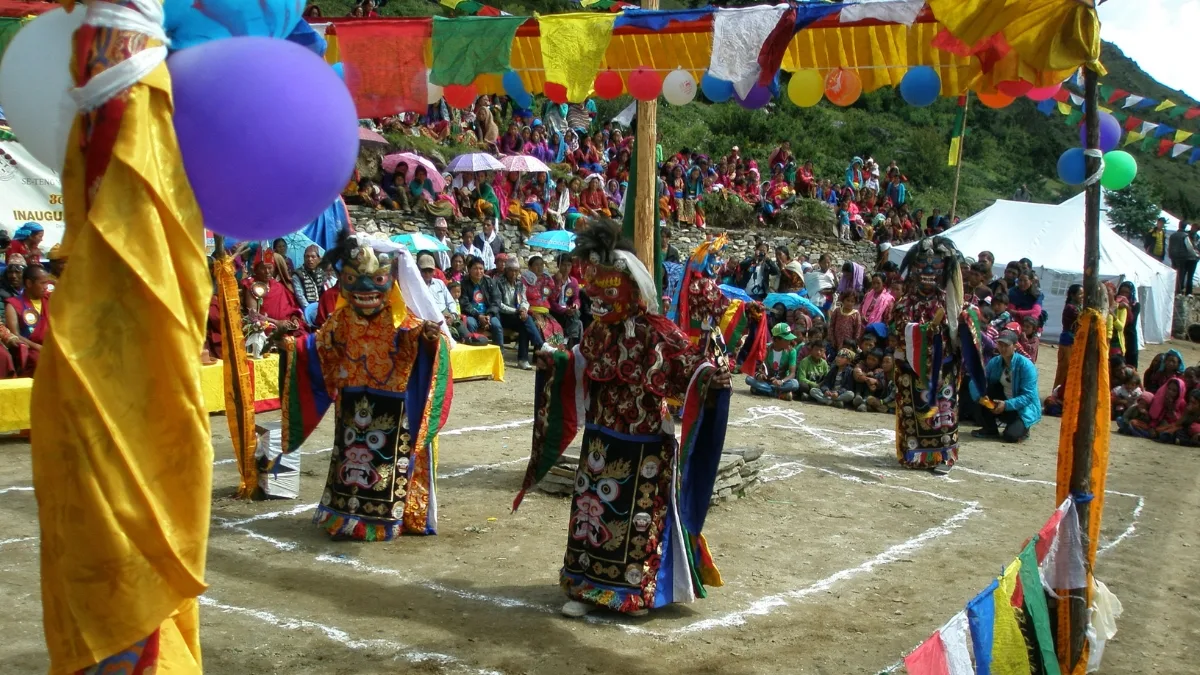
Dolpo’s culture is mostly shaped by Tibetan Buddhism and the old Bon religion, giving the area a special spiritual feel. Villages have stone houses with flat roofs, decorated with bright prayer flags and mani stones, showing architecture that has been around for hundreds of years.
Local people wear traditional clothes made from yak wool and cotton, made for living in high mountains. Festivals and rituals are a big part of daily life, like masked dances, prayer ceremonies, and seasonal celebrations at monasteries. Monks and villagers keep old customs alive, from farming to yak herding, which have stayed mostly the same for many generations.
Visitors should travel respectfully by asking before photographing, dressing modestly, and observing monastery rules, which helps preserve the harmony and authenticity of Dolpo’s culture. Experiencing these traditions firsthand is one of the most rewarding aspects of trekking in the region.
Plan Your Ultimate Upper and Lower Dolpo Trek – Discover routes, culture, and adventure with ease.
Hiring Guides and Porters
In Dolpo, you must hire a guide for Upper Dolpo because of permit rules and how remote the area is. In Lower Dolpo, it’s optional but still a good idea. Guides help with finding your way, getting permits, understanding the culture, and staying safe, making them really important for first-time visitors.
Porters carry camping gear, food, and personal belongings, which allows trekkers to conserve energy for long days at high altitude. Typical costs range from USD 25–30 per day. We highly suggest following an Upper Dolpo trekking guide or Lower Dolpo trek itinerary.
Hiring local guides and porters not only helps the community but also makes the trek better with their insider knowledge, tips about local culture, and quick help in emergencies, making the Dolpo experience safer and more fun.
Wildlife and Natural Wonders of Dolpo
Dolpo is home to some of the rarest and most elusive Himalayan wildlife. Trekkers may encounter snow leopards, Himalayan blue sheep, musk deer, and Himalayan tahr, as well as various high-altitude birds like griffon vultures and Himalayan monals.
The region also has unique mountain plants and medicinal herbs, many of which are found only here and are important to local communities. Valleys and high passes are untouched and protected by Shey Phoksundo National Park, which takes care of both plants and animals.
Seeing wildlife is rare but exciting, and it’s really important to respect these delicate ecosystems. Staying on trails, not disturbing animals, and following park rules helps keep Dolpo a safe home for its nature for generations to come.
Preparation, Fitness, and Packing Tips
Trekking in Dolpo requires both physical and mental preparation. As the trek is challenging, it is best if you are prepared and have prior trekking experience. Following Dolpo region travel tips ensures you don’t miss anything important.
- Build endurance: Do long hikes, walk uphill, and do cardio exercises to make your stamina stronger.
- Strength training: Focus on your legs, core, and back so you can handle long days with a backpack.
- Acclimatization: Slowly go higher during the trek to lower the risk of altitude sickness.
- Mental readiness: Get ready for long times alone, simple facilities, and remote living. Being patient and flexible is very important.
- Hydration and nutrition: Practice staying hydrated and eating energy-rich meals during training to mimic trekking conditions.
As for your preparation for the packing, you will need a lot of things for your trek to be comfortable and easy. Some of these essentials are as follows:
- Wear layers of clothes for changing temperatures, including thermal layers and waterproof jackets.
- Bring strong trekking boots and trekking poles for rough paths.
- Pack warm gloves, a hat, and thick socks for the cold at high altitudes.
- Carry a sleeping bag that works in below-zero temperatures for camping in Upper Dolpo.
- Bring a first-aid kit with medicine for altitude sickness, painkillers, and bandages.
- Don’t forget sunglasses, sunscreen, and water purification tablets.
- Take a solar charger or power bank for your devices.
- Snacks or energy bars for long trekking days.
Safety, Precautions, and Emergencies
Trekking in Dolpo involves high altitudes, remote terrain, and limited facilities, so safety planning is crucial.
- You can avoid altitude sickness by going up slowly, taking rest days, drinking plenty of water, and not drinking alcohol.
- Emergency evacuation by helicopter is possible in Upper Dolpo, but it is weather-dependent and costly, so always have a contingency plan and ensure your insurance covers high-altitude rescue.
- Communication is limited as mobile coverage is minimal, so using satellite phones or guide radios is recommended. Always inform your agency or guide of your daily plan.
- Weather and trail hazards, including snow, landslides, or sudden changes, can occur. Check local updates before crossing high passes and use trekking poles for stability.
- Travel insurance should cover trekking above 4,000 meters, medical emergencies, and evacuation, and it’s wise to keep a copy of your policy details accessible.
Tips for Trekking in the Dolpo Region
Before heading into Dolpo’s remote valleys and high passes, it’s important to be well-prepared. These tips cover the key steps for staying safe and respectful while trekking in one of Nepal’s most untouched regions.
- Physical preparation is essential, so train with long hikes, uphill walking, and cardio to build endurance.
- Get used to high altitudes slowly to lower the risk of altitude sickness and make your trek safer.
- Hire a registered guide for Upper Dolpo, and think about having one for Lower Dolpo to help with trails and learn about the local culture.
- Bring important things like layered clothes, trekking poles, first-aid supplies, and enough water for long days.
- Travel responsibly by respecting local customs, minimizing waste, and following leave-no-trace principles to protect Dolpo’s environment.
- Keep cash on hand as ATMs are unavailable, and plan for basic facilities along the trail.
- Follow Dolpo region travel tips throughout the trek.
Final Thoughts: Step Into Nepal’s Hidden Gem
Dolpo is a place with peaceful valleys, tall mountains, and old traditions, where every step feels like going back in time. Trekking here isn’t just about the scenery—it’s about seeing a culture and land that has mostly stayed the same without modern changes.
Whether you go to Upper or Lower Dolpo, the region gives back your patience, preparation, and respect with quiet moments, spiritual experiences, and amazing natural beauty. Traveling responsibly helps keep Dolpo untouched for future generations.
Start planning your Dolpo adventure with Nepal Gateway Trekking to explore one of Nepal’s last untouched paradises. Contact us!
FAQs – Upper and Lower Dolpo Trek
How difficult is the Dolpo trek?
The trek ranges from moderate to challenging. Upper Dolpo is more challenging due to high passes, remote trails, and limited facilities, while Lower Dolpo is slightly easier with more accessible villages and shorter daily distances.
Can foreigners visit Upper Dolpo without a guide?
No. Hiring a registered guide is mandatory for Upper Dolpo to comply with Restricted Area Permit regulations and ensure safety in this remote region.
What permits are needed for the Dolpo trekking?
Trekkers need a Restricted Area Permit for Upper Dolpo and a Shey Phoksundo National Park entry permit. A passport copy and guide registration are required for application.
How do I reach Dolpo from Kathmandu?
Most travelers fly from Kathmandu to Nepalgunj, then take a small plane to Juphal, the main trailhead for Upper Dolpo. From there, trekking begins on foot. Lower Dolpo can also be accessed via jeep routes from Dunai.
What makes Shey Phoksundo Lake special?
Shey Phoksundo Lake is known for its turquoise waters, high-altitude setting, and spiritual significance, surrounded by remote villages and snow-capped peaks.
Is Dolpo safe for solo travelers?
Solo trekking in Upper Dolpo is not allowed due to regulations. Lower Dolpo is safer for experienced solo trekkers, but hiring a guide is still recommended for navigation and local insight.
When is the Shey Festival celebrated?
The Shey Festival happens every year during august or september, depending on the lunar calendar. It includes traditional dances, rituals, and local community gatherings at Shey Gompa.
